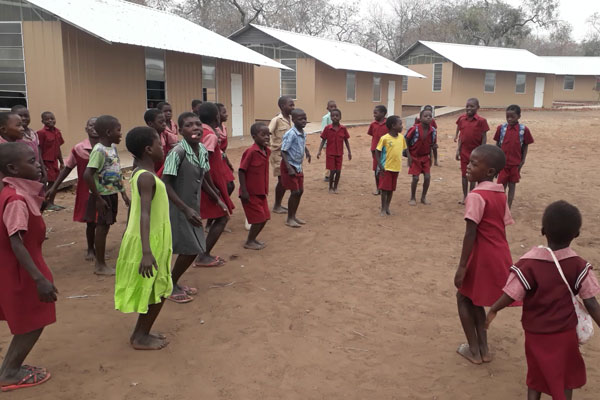
Two years ago, a modern school built by the SeventhDay Adventist (SDA) church in the Mariga area of Mbire district, was lying idle after government suspended its opening.
BY TAPIWA ZIVIRA

The government insisted that Mariga Primary School did not meet all the statutory requirements.
The irony, however, was that the school was constructed in response to the lack of educational facilities within the remote area, and pupils were forced to walk 16km through the wildlife-infested forests.
They had to cross the wide Mwazamutanda River in order to access the nearest school at Chapoto.
Mariga, home to the Doma people, is situated on the edges of the Zambezi River, where dangerous wild animals such as lions and elephants, among others, roam free.
And without any road or other communication infrastructure, the place resembles a forgotten land, where the Doma, apart from not getting education, have to learn tough survival skills from an early age.
Following realisation that the government was turning a blind eye to the plight of the Doma people, the Centre for Community Development in Zimbabwe (CCDZ) conducted a survey that revealed that in addition to the long distance to school, hunger, lack of proper clothing including uniforms for children hindered access to education in the area.
- Chamisa under fire over US$120K donation
- Mavhunga puts DeMbare into Chibuku quarterfinals
- Pension funds bet on Cabora Bassa oilfields
- Councils defy govt fire tender directive
Keep Reading
less than five Doma children complete Grade Seven annually.
Two years ago CCDZ, determined to advocate for the improvement of the livelihoods of the Doma people, took members of the parliamentary portfolio committee on education to Mariga so the legislators could see the neglect for themselves.
The MPs had a chance to interface with the reality that no news story could have accurately told.
The organisation went on to produce a documentary on the life of the Doma people, which was carried by our sister paper NewsDay on its website.
Last year, The Standard — as part of its 20th anniversary commemorations — partnered with CCDZ to donate clothing and food items to the Doma community.
Meanwhile, CCDZ continued working behind the scenes, lobbying for, among other things, the opening of the school.
“Our organisation played a key role in engaging the Ministry of Primary and Secondary Education, Mbire Rural District Council, parliamentarians and local leaders, who were all supportive,” said CCDZ director Phillip Pasirayi.
“We organised field visits to Mbire with MPs and journalists, and mobilised other NGOs to understand the plight of the Doma children and the urgent need for Mariga Primary School to be opened so that children who were not going to school for various reasons could enrol at the new school.”
Two years later, it appears CCDZ’s efforts are beginning to pay off, as the eerie silence that once haunted the hill at Mariga, where the SDA-built school stands, has now been replaced by joyful singing and dancing of children.
The school opened its doors in May after government finally gave the community the green light.
“It is through our advocacy efforts that government and some private sector players are stepping up efforts to improve the quality of education and health of the Doma people in Mbire district,” said Pasirayi.
The opening of the school, it appears, was just the beginning.
According to Brighton Kafanja, a teacher at the school, they have registered about 253 pupils from early childhood development (ECD) classes to Grade Three, and there are some who are yet to start attending classes due to various reasons.
“It might take some time because we have some who are now as old as 16 or 18 but have never attended school,” Kafanja said.
“It will not be easy for them to sit on the same bench as six-year-olds, so there is need for an arrangement to cater for them. It could be an adult education facility.
“Another thing is that this was initially meant to be a secondary school, and the school originally meant to be for primary education is being built next door.
“So we will continue to house these primary pupils here because there are no secondary schoolsgoing students here.”
Beauty Njanji, a villager at Mariga, believes the efforts by CCDZ, which opened way for other stakeholders to intervene, would help reduce the scourge of child marriages in the area as children would now be preoccupied with education.
“Going to school helps our children liberate their minds and think beyond life in Mariga,” she said.
“When they were idle, they would not have dreamt of being pilots, teachers or nurses.”
Another villager, Precious Pondo, called for more support saying the community was poor.
“We require nutritional support for the children so that they can be motivated to go to school,” Njanji said.
“The other challenge is that the Doma people do not have enough clothing, and this discourages them from enrolling at school.”
Apart from the opening of the school, several complementary interventions are being carried out in the area to ensure they sustain themselves using the resources in their environment.
First lady Auxilia Mnangagwa, who was in the area recently, facilitated the installation of a solar-powered borehole to provide water at Mariga Primary School, and to complement the manual borehole already installed, and these are also being used by the entire community.
Various non-governmental organisations (NGOs) have also stepped in to assist with market gardening projects to support the nutritional needs of the Doma people, who, without access to hunting and gathering, have no other economic activity to undertake.
“We are happy that while we still require more direct nutritional support for our children in school, at least we have established market gardens to grow vegetables, and this is helping a lot and in future we hope to have more projects that include livestock,” said Njanji.
Njani said they use organic manure sourced from composts and small livestocks like goats that they have in the community.
In order to support the Doma people’s medication needs, and to reduce the child mortality rate, a clinic in the area was recently refurbished with assistance from government and other NGOs, and according to the nurse in charge, they are getting enough medication to cater for the community.
The District Development Fund has also started constructing a road that links Mariga to the Kanyemba road, while CCDZ and Higher Life Foundation are separately constructing classroom blocks.
“So, as you can see, in addition to getting education, we are happy the people of Doma are now getting access to clean water, a clinic that enables them to get medical facilities and all this feeds into sustainable livelihood”
BELOW IS THE DOCUMENTARY MADE IN 2016, ABOUT THE PLIGHT OF THE DOMA PEOPLE











